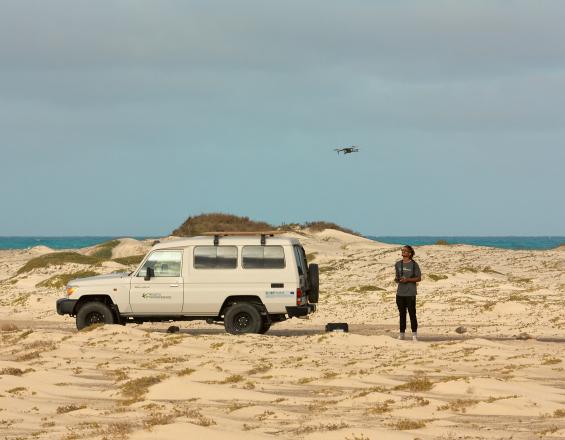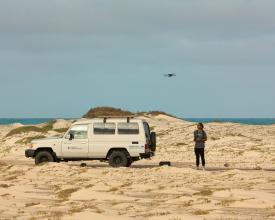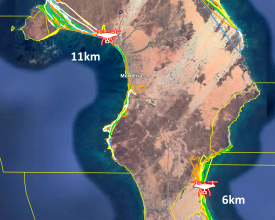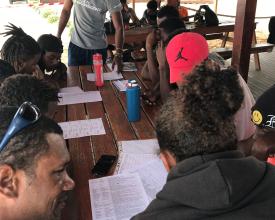
Advanced technology enhancing convectional efforts: use of drone patrols in a effective anti-poaching for loggerhead turtles

Cabo Verde is, probably, the largest nesting site in the world for Loggerhead turtles, listed as threatened on the IUCN Red List, nevertheless, many threats are compromising their survival. One of the main threats for adult turtles in Sal Island is hunting of nesting females which increased during and after the COVID-19 pandemic. In response, foot and drone patrols were implemented within three MPA’s, and in suitable flying conditions, the accessible bays of a fourth MPA was also patrolled. These patrolled were enhanced by the purchase of more advanced drones with infra-red imaging. Local employment, targeted at nearby communities to the MPA’s, and community initiatives were also crucial as part of the solution. As a result, poaching levels were drastically reduced within all targeted MPA’s, community partnerships were strengthened and overall protection within the MPA’s was reinforced. This project was supported by the European Union and the Organisation of ACP States through the BIOPAMA Programme.
Context
Challenges addressed
An increase in poaching levels covering large nesting areas in response to the COVID-19 pandemic were addressed directly via use of drone patrols using advanced technology with infra-red capabilities, allowing detection and response to poaching activity. Foot patrols were also increased in the most affected MPA of Murdeira with daily assistance from the military. Employment for this patrol team was targeted at the neighbouring community, considered to be a contributor to the increase in poaching, as a means of sensitisation within the local population. Other sensitisation strategies were implemented with the strengthening of the community partnership with the local Fishermen’s Associations, who conducted voluntary patrols in their local areas.
Location
Process
Summary of the process
In order to implement effective patrols, training was given to all employees and stakeholders that would be relied upon throughout the nesting season. Through continuous training and a greater understanding of conservation practices, the patrol team were provided with the skills and knowledge to allow a greater satisfaction in their job and therefore an increased level of empathy in conserving this turtle population. Effective foot patrols, assisted by the military, were enhanced by the use of advanced technology, and, upon detection of infractions within the targeted areas, the national police were called upon to respond to such infractions. With the limited accessibility for some nesting beaches, despite the ability of the advanced technology to detect infractions, detainment of those people was not always possible. For this reason, the combination of this advanced technology to act as a deterrent and the continued sensitisation of the local population work hand in hand as an effective long-term solution in conserving an endangered turtle population.
Building Blocks
Use of advanced technology
Use of advanced drone technology with thermal and infra-red imaging allows greater capture of infractions within the targeted areas, as well as the ability to travel further distances for longer time. This technology allows greater distances to be covered with less resources required, for example, more isolated nesting beaches that would require a larger team of people for security reasons, or more complex logistics in locating teams to those beaches.
Enabling factors
Intensive training, or recruitment of a qualified person(s), to use this advanced technology is essential. In this case the drone pilots had previous experience in night flights using thermal imaging so were able to quickly learn how best to use and understand the new infra-red camera imaging. It is also essential that the persons have knowledge of the target area and experience in navigating within the area, both via drone and by vehicle.
Lesson learned
Advanced technology is useful in itself but is much more effective when partnered with conservative techniques. In this case, whilst the drone patrol was effective in covering a large area, quickly, it was unable to fly over the full time period (all night). Therefore, when combined with foot patrols, it enhanced coverage within the MPA and allowed for greater protection withing the MPA and it’s surrounding isolated beaches. It is also important to consider that whilst the drone could quickly and easily reach isolated areas, when infractions were discovered, the response of the suitable people (either foot patrols or authorities) was much slower, allowing for poachers to escape being detained. Whilst effective for deterrent of poaching, which was an advantage in this case, for other contexts this may be a strong factor in planning the strategy.
Stakeholders’ engagement and sensitisation of local population
Working with local authorities (City Hall, Military and National Police) required prior strategic meetings and training of their personnel. Training prepared the military personnel for assistance in night patrols throughout the season, providing security to our employees whilst also sensitising them to conservation practices. It is common to receive job applications from military personnel after they have finished their service due to this experience and sensitisation. Meetings with the city hall and national police allow the conservation strategy to be shared, allowing for more effective response to infractions during the season. Whilst this was an uncommon event, even those infrequent encounters allowed for engagement and sensitisation of police officers and technicians of the council. Community engagement through initiatives such as the partnership with the local fishermen’s associations, was successful in sensitisation of a key community in conservation practices. This was achieved through giving incentives to the association (e.g. donation of material) in return for volunteer patrols of a beach neighbouring the MPA of Costa Fragata.
Enabling factors
Contact and training with the relevant authorities; City hall, Military, National Police. An established connection with the community groups targeted through previous partnerships/projects or a spokesperson within that community that can encourage their community to partake in such initiatives. Continuous communication and follow up with all stakeholders throughout the project implementation and after through alternative means of sensitisation.
Lesson learned
Direct employment is not necessarily the best and only option to engage with the local community. Constant presence before, during and after project implementation is key to a strong partnership or sensitization effect within the community and the stakeholders. Understanding the motivations or requirements of targeted communities and stakeholders can allow for a stronger, longer lasting partnership. The more knowledge and skills that can be shared in preparation for implementation of the project allows for a more effective implementation of the strategy. An example in this case, with the training of the military prior to the initiation of the patrols, a greater level of participation and interest was observed from the soldiers.
Training
All employees received theoretical and practical training on sea turtle conservation practices prior to the initiation of foot and drone patrols. Training covered sea turtle biology, patrol protocols and tagging of turtles, followed by practical training on the use of GPS, track identification, turtle tagging, nest relocation and excavation. Continuous practical training was conducted throughout the season during patrols targeted at the employee’s experience. Those in positions such as team leader were also given continuous support and training to improve on their leadership skills.
Enabling factors
The training was conducted by professionals with many years of experience in the field of turtle conservation. The training is effective due to the design and strategy implemented thanks to the experience of the coordination team. The availability of these professionals to cover all areas of implementation allowed the continuous training to be made available to the full team.
Lesson learned
To implement the training requires professionals with the capacity and aptitude to effectively train both new and experienced employees. The key to being able to effectively train the full team was in having a combination of new and experienced employees, to allow the project (in this case, the patrols) to be implemented effectively whilst continuing with training. The ability to train a large team with few professionals is hindered with a large number of new recruits.
Impacts
The population of Sal in general have benefitted from this project through improved protection of the loggerhead population. Eco-tourism activities surrounding this species were a continuing attraction which are known to generate over 500,000€ of income per year. Directly, this project benefitted 11 young people (7 rangers, 2 drone pilots and 2 assistants) through employment during the nesting season, therefore additionally benefitting their families with a generated income. The local fishermen’s associations received further training and conducted nightly patrols on a beach bordering one of the targeted MPA’s. Enforcement authorities engaged and participated in the antipoaching patrols, with training given to more than 120 new soldiers which joined the patrols daily. Strengthening of protection within the MPA’s; poaching was reduced by 84% in the MPA of Costa Fragata, 81% in the MPA of Murdeira and 45% in the MPA of Ponta Sino. In total, 551 drone flights were conducted, over 123 hours of flight, covering four MPA’s.
Beneficiaries
The Delegation of the Ministry of Agriculture and Environment
National Police
The Military
The City Hall
Fishermen's Associations
Local employees of Projeto Biodiversidade
Local tour guides (turtle-watching excursions)
The population of Sal in general
Sustainable Development Goals
Story
During and after the COVID-19 epidemic, poaching within the MPA of Murdeira increased drastically, attributed in part to the nearby community which had a high rate of unemployment and poor living conditions. In response, in 2021 a volunteering initiative was introduced, and in 2022 was built on by targeting these volunteers for recruitment. One candidate was a known poacher within the community, however through direct contact with the project he became the primary contact point in further engaging the community. He volunteered for patrols in 2021 and assisted in other community outreach outside of the turtle season and was therefore employed in 2022. Throughout his employment he has shown reform in his attitude to turtles, has gained skills in turtle conservation, has demonstrated commitment to the preservation of turtles and has secured a job for future nesting seasons.


